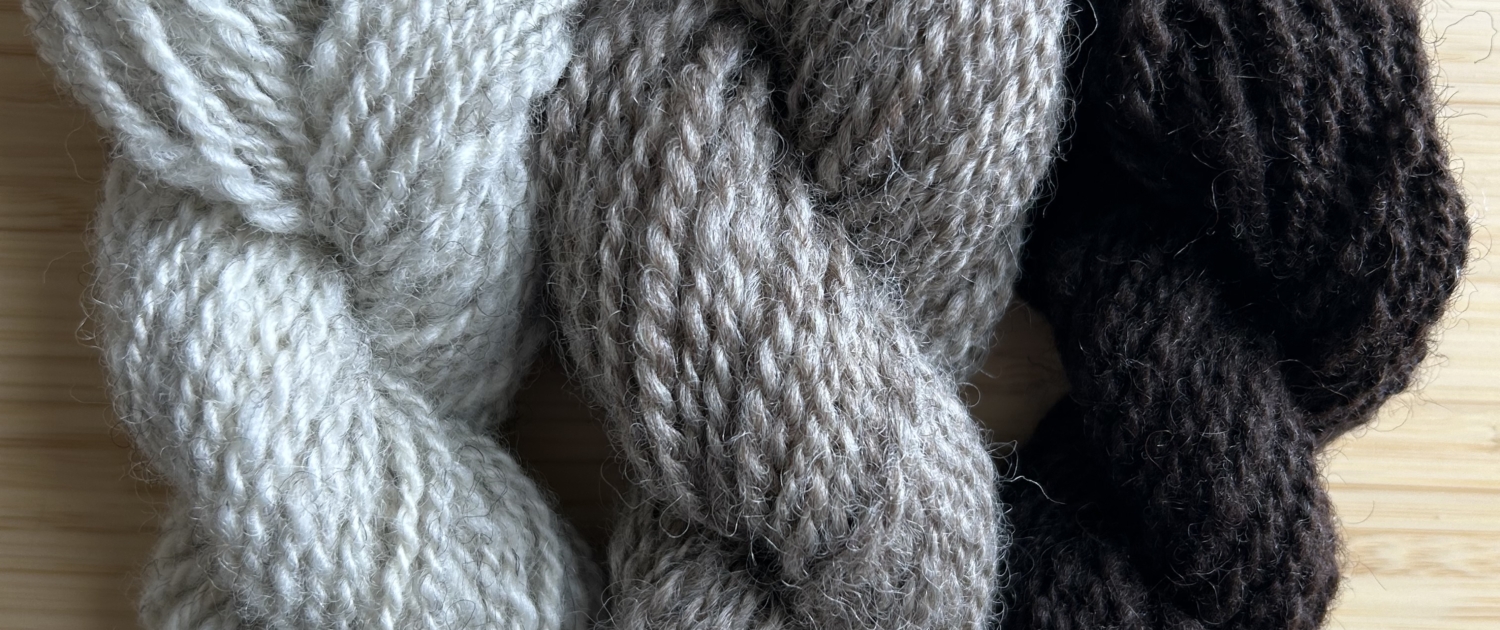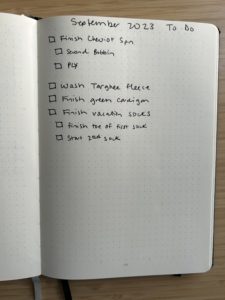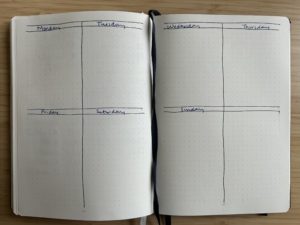Journaling is a powerful tool to combine with your spinning practice. Journaling – the process of noting down your thoughts and daily highlights – can grow your spinning practice by encouraging planning, tracking, and reflecting. Personally, I love a paper notebook, but you can easily create a digital journal that enhances your spinning and doesn’t take too much time away from the wheel or spindle. In my experience, a small amount of journaling helps me dedicate more time to spinning.
Planning
My journaling practice developed after learning about the Bullet Journal method. Bullet Journaling is a flexible way to prioritize your to-do list while also promoting intentionality and reflection. If you are curious about the method, I encourage you to check out the website bulletjournal.com for more detailed information.
Every Sunday morning, I make a cup of hot coffee and settle into my crafting corner with my journal and some colorful pens. Any notebook, planner, or electronic calendar will work, but my personal preference is a dot grid notebook with 120 GSM paper. In my notebook, I sketch out a weekly calendar, spread out over two pages when it lays flat. Each day has its own column, in which I note any commitments and determine when I want to do household chores.
At the beginning of the month, I dedicate a page to writing out all of my goals for the next thirty days. What are the things I’d like to accomplish this month? Often this list is full of creative projects: finish the Corriedale spin, organize my stash, swatch for that cardigan. Then I break down the steps of the intended project and note them beneath the goal. Once I have detailed which activities I will need to do to accomplish my goal, I add those activities to the week I have just planned out. For example, I might add “divide and weigh the fiber” as a to-do item for Monday. And when I finish that and check it off, I may add another item for Tuesday that will help to move the project along. While it may seem complicated and add extra steps to an already busy life, I find that taking the 10–15 minutes to plan out my week is quite enjoyable. I’m drinking my coffee and I’m easing the anxiety of the upcoming week because I know what I need to do for myself and my family, but I’m also adding spinning in as a priority.
My journal is also helpful for planning out a bigger project. I like to write the name of the project at the top of the page – “Handspun Sweater” for example – and then start brainstorming. A goal I have this year is to spin a large quantity of local wool and then knit that into a sweater. I brainstorm some things that will need to happen to get this project going: research local farms to see what fiber is available; consult some fiber books to see which breed characteristics I would like for my sweater; calculate how much fiber I’ll need; search for a few patterns that I would like to knit. Instead of being overwhelmed by all of the steps, I have a starting place, and once I complete one step I can move on to the next, until all the steps are completed. Then I can have another brainstorming session in a few weeks to plan for the next parts in the project.
Tracking
Journals are also invaluable for tracking and cataloging your projects. For tracking, I find that digital tools can be more comprehensive, but a paper notebook will work just as well. Ultimately, the best tool for you is the one you will use most consistently.
If the project planning above sounds like too much, I encourage you to at least keep track of your spinning projects, even if it’s only a few notes. I like to record the type of fiber, where I got it, how I prepped it, how many finished yards I got, number of plys, the ply twist, and other ideas/thoughts I had on the spin. Generally I’ll keep a few notes in my everyday journal and then I’ll create a more detailed project page in the Notion app. Here I can easily add photos and links. Ravelry also has a comprehensive spinning project page template.
If you are the type of spinner who has multiple projects going at once, having tracking notes can help you more easily get back into a project if you’ve stepped away for a while. Each of us only has so much brain power, so leveraging an external tool like a journal to store some of our thoughts and memories is a huge cognitive win.
Reflecting
Once you’ve developed several plans and tracked the subsequent projects, you will be more equipped to reflect on your spinning and your growth as a spinner, and maybe even as a human being.
An important part of the bullet journal process is to look back at prior weeks and months to reflect on what you did and move toward the things that are important in your life. Did you write in your monthly goal page that you wanted to dye some of the longwool locks you have, but you never completed any to-do items related to that project? Maybe it’s time to take it off the list and add something that excites you more. Did you notice that you spun the braids from that one shop faster than any others? This is an insight that shows you may want to focus your stash building with them. Besides the practicality of having a plan for our week or month, journaling allows us to take a step back and view our actions more objectively, and then change our spinning practice, or life, accordingly. With the pace of modern life and the number of distractions coming at us from all directions, journaling anchors us to our true motivations and wishes for our lives.
If you find these practices helpful, I encourage you to try this last one, which is my personal favorite: morning pages, invented by Julia Cameron, author of The Artist’s Way and many other books on creative living. The main premise is to complete three freehand pages of writing first thing in the morning. Write anything and everything that comes to your mind. This brain dump frees up space taken up by thoughts that just want to be let out, setting you up to be more creative for the rest of the day. I have adapted the morning pages to my own needs. I write as much as I can for about ten to fifteen minutes and then begin my day. I may not write three full pages, but I still find that my mind feels lighter afterward. Over time, I noticed that the morning pages end up being intentions for my day. I may write that I hope I can finish this project or that I can’t wait to play with that fiber. By releasing my mental burdens in the morning and writing out my hopes for the day, I find that I am able to stress less about what I have worried about in the pages and accomplish more of what I wrote I would like to do.
Katherine Mead is a knitter, spinner, and lover of all things fiber and textiles. She writes a weekly newsletter called Meander Textiles, where she shares lighthearted takes on crafting. She currently lives in Chicago with her fiber-loving cat, Olive, and a supportive partner.







Leave a Reply
Want to join the discussion?Feel free to contribute!